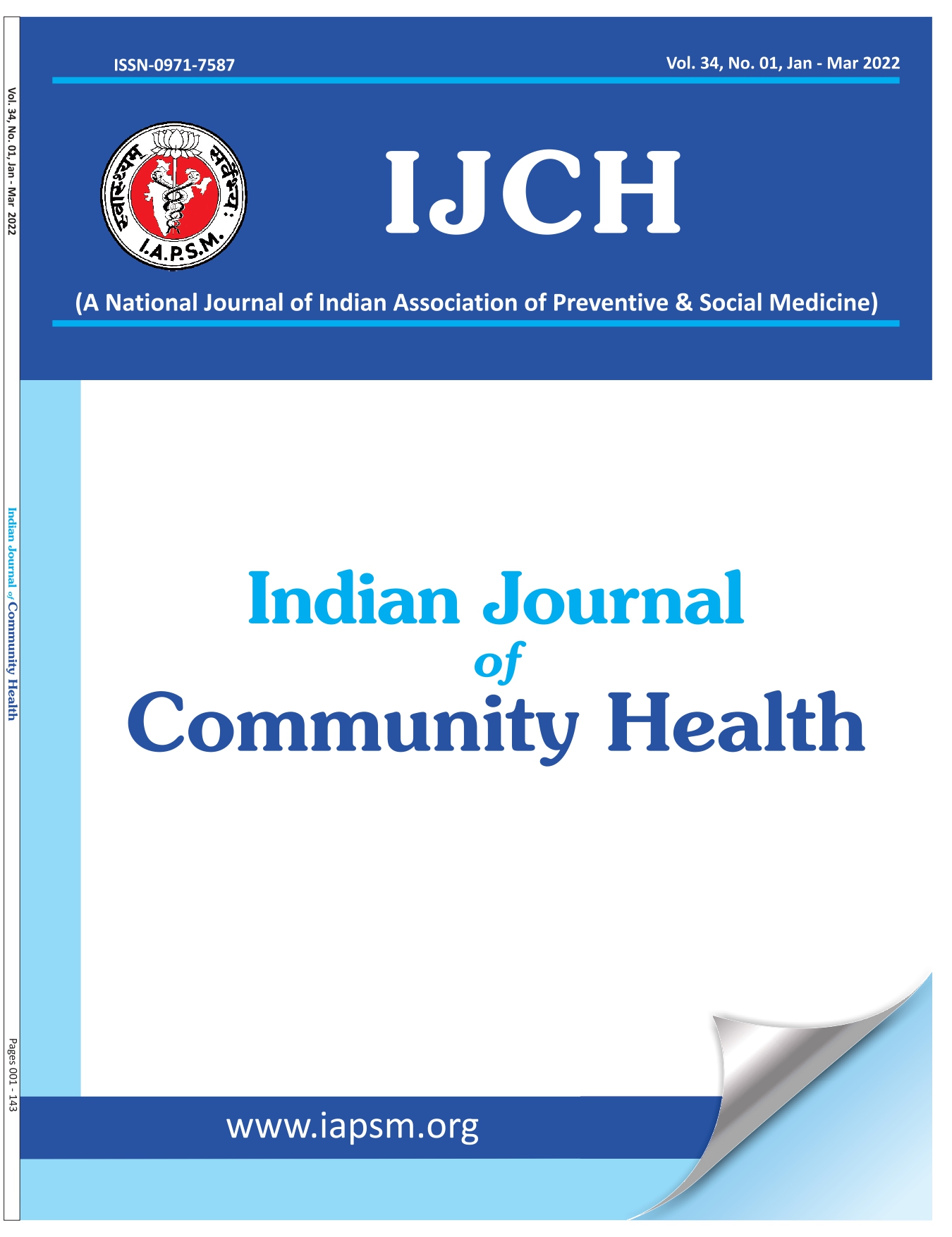Redefining Assistive Technology: A Shift from Disability to Functional Impairments in Policy and Practice
DOI:
https://doi.org/10.47203/IJCH.2025.v37i02.028Abstract
Achieving the Sustainable Development Goals (SDG) and ensuring inclusive universal health coverage (UHC) with the goal of “leaving no one behind” has sparked a global dialogue on Assistive Technology (AT) or Assistive Products (AP).(1) This conversation has driven innovation and transformed lives, yet the unmet needs for AT are significant globally. The WHO-UNICEF Global Report on Assistive Technology (GReAT) 2022 reported that in low- and middle-income countries (LIMCS), as low as 3% of the population needing AT has access to these life-changing tools.(2) Further, it is estimated that by 2050, two billion people will require AT, yet 90% of them, particularly in LMICs, will lack access.(3)
The International Organization for Standardization (ISO) has defined “assistive product as any product (including devices, equipment, instruments, and software), specially produced or generally available, used by or for persons with disability for participation; to protect, support, train, measure or substitute for body functions/structures and activities; or to prevent impairments, activity limitations or participation restrictions.(4) For ease of understanding, the authors use AT as the umbrella term in the rest of the article for Assistive technology or aids or products or services.
Downloads
References
World Health Organization. Assistive technology [Internet]. 2024 [cited 2025 Apr 25]. Available from: https://www.who.int/news-room/fact-sheets/detail/assistive-technology
World Health Organization, United Nations Children’s Fund. Global Report on Assistive Technology. Geneva: WHO and UNICEF; 2022.
Global Disability Innovation Hub. AT 2030: Life-Changing Assistive Technology for All [Internet]. 2021 [cited 2025 Apr 25]. Available from: https://www.disabilityinnovation.com/at-2030
International Organization for Standardization. Assistive Products for Persons with Disability—Classification and Terminology (ISO 9999) [Internet]. 2016 [cited 2025 Apr 25]. Available from: https://www.iso.org/standard/60547.html
Senjam SS, Kumar P, Manna S, et al. Assistive technology usage, unmet needs and barriers to access: a sub-population-based study in India. Lancet Reg Health Southeast Asia. 2023;15:100213.
Gramstad A, Storli SL, Hamran T. “Do I need it? Do I really need it?” Elderly people’s experiences of unmet assistive technology device needs. Disabil Rehabil Assist Technol. 2012;8(4):287-93.
United Nations. Convention on the Rights of Persons with Disabilities [Internet]. 2006 [cited 2025 Apr 25]. Available from: https://www.un.org/development/desa/disabilities/convention-on-the-rights-of-persons-with-disabilities.html
Barbotte E, Guillemin F, Chau N. Prevalence of impairments, disabilities, handicaps and quality of life in the general population: a review of recent literature. Bull World Health Organ. 2001;79(11):1047-55.
The Oxford Review. Functional impairment—definition and explanation [Internet]. 2024 Nov 29 [cited 2025 Apr 25]. Available from: https://oxford-review.com/the-oxford-review-dei-diversity-equity-and-inclusion-dictionary/functional-impairment-definition-and-explanation/
World Health Organization. International Classification of Impairments, Disabilities, and Handicaps: A Manual of Classification Relating to the Consequences of Disease. Geneva: WHO; 1980.
Cilv?ks, nevis diagnoze. What are functional impairments? [Internet]. [cited 2025 Apr 25]. Available from: https://cilveksnevisdiagnoze.lv/en/what-are-functional-impairments/
ATscale. About assistive technology [Internet]. 2024 [cited 2025 Apr 25]. Available from: https://atscalepartnership.org/about-assistive-technology
Medicines and Healthcare products Regulatory Agency. Assistive technology: definition and safe use [Internet]. 2021 [cited 2025 Apr 25]. Available from: https://www.gov.uk/government/publications/assistive-technology-definition-and-safe-use/assistive-technology-definition-and-safe-use
The National Trust. Aids and assistive devices: Ministry of Social Justice and Empowerment (MSJE) [Internet]. [cited 2025 Apr 25]. Available from: https://thenationaltrust.gov.in/content/innerpage/aids-and-assistive-devices.php
Government of India. The Rights of Persons with Disabilities Act, 2016. New Delhi: Ministry of Law and Justice; 2016 [cited 2025 Apr 25]. Available from: https://legislative.gov.in/actsofparliamentfromtheyear/rights-persons-disabilities-act-2016
Department of Empowerment of Persons with Disabilities. Revision of Scheme of Assistance to Persons with Disabilities for Purchase/Fitting of Aids/Appliances (ADIP Scheme). New Delhi: DEPwD; 2024 [cited 2025 Apr 25]. Available from: https://adip.depwd.gov.in/files/ADIP_English.pdf
Press Information Bureau. Implementation of Rashtriya Vayoshri Yojana [Internet]. 2023 [cited 2025 Apr 25]. Available from: https://pib.gov.in/PressReleasePage.aspx?PRID=1982750
PTI. 18 percent of India’s population requires assistive care solutions, says former DGHS. Hindustan Times [Internet]. 2024 [cited 2025 Apr 25]. Available from: https://www.hindustantimes.com/health/18-per-cent-of-india-s-population-requires-assistive-care-solutions-says-former-dghs-101710046401364.html
National Statistical Office. Elderly in India. New Delhi: Ministry of Statistics and Programme Implementation; 2021.
Rashmi R, Mohanty SK. Examining chronic disease onset across varying age groups of Indian adults using competing risk analysis. Sci Rep. 2023;13(1):5848.
Hacker K. The burden of chronic disease. Mayo Clin Proc Innov Qual Outcomes. 2024;8(1):112-9.
Indian Council of Medical Research. Priority-Setting Exercise for Shortlisting National List of Essential Assistive Products (NLEAP). New Delhi: ICMR; 2023 [cited 2025 Apr 25]. Available from: https://www.icmr.gov.in/icmrobject/static/icmr/dist/images/pdf/reports/ICMR_Assistive_Technology_Product_List_WEB.pdf
World Health Organization. Almost one billion children and adults with disabilities and older persons in need of assistive technology denied access: report [Internet]. 2022 [cited 2025 Apr 25]. Available from: https://www.who.int/news/item/16-05-2022-almost-one-billion-children-and-adults-with-disabilities-and-older-persons-in-need-of-assistive-technology-denied-access–according-to-new-report
Downloads
Published
How to Cite
License
Copyright (c) 2025 Ishita Goyal, Salaj Rana, Geeta Rani, Suraj Singh Senjam, Ravinder Singh

This work is licensed under a Creative Commons Attribution-NonCommercial-NoDerivatives 4.0 International License.





